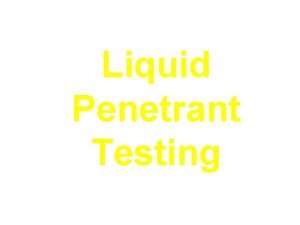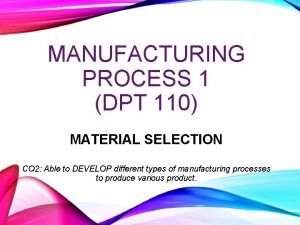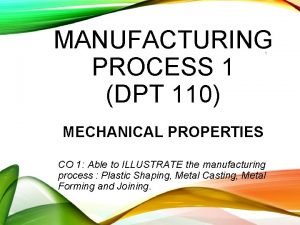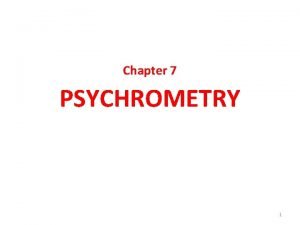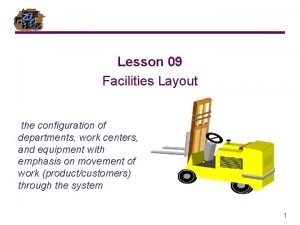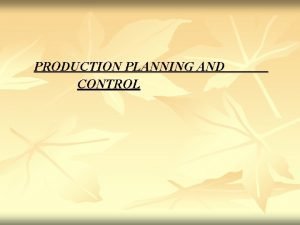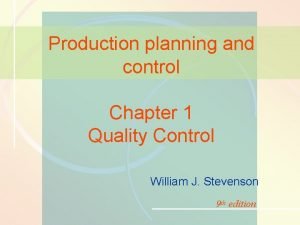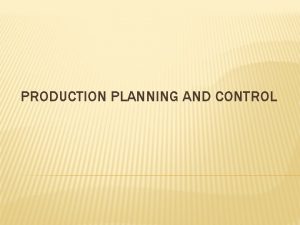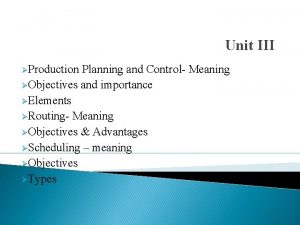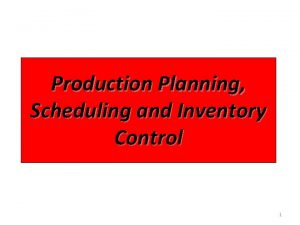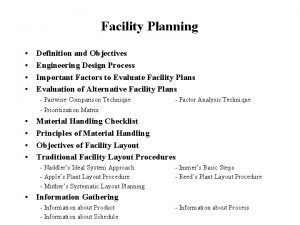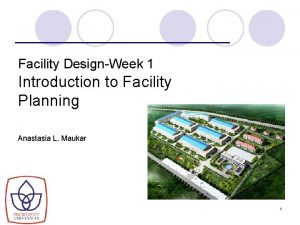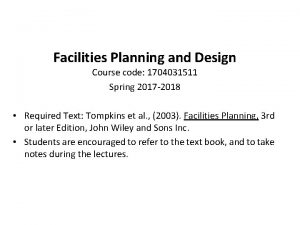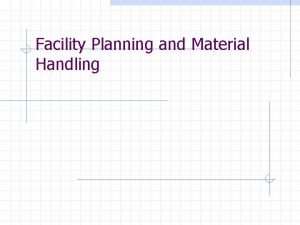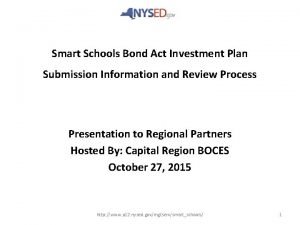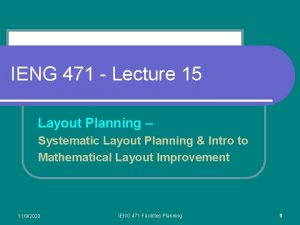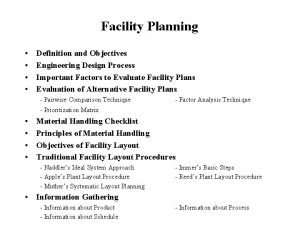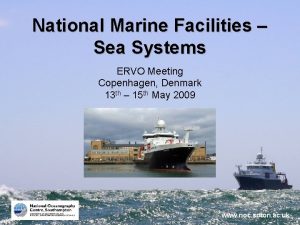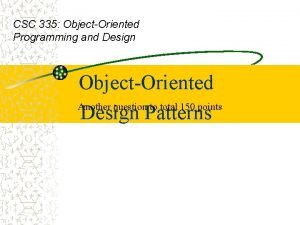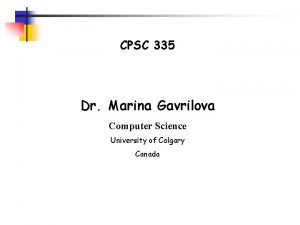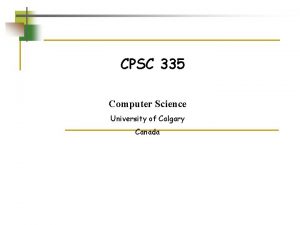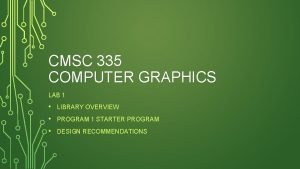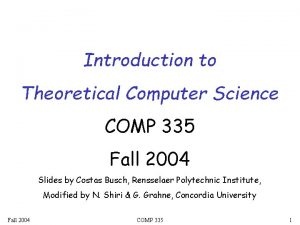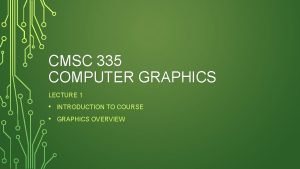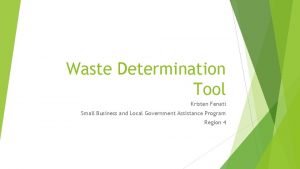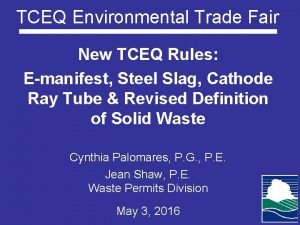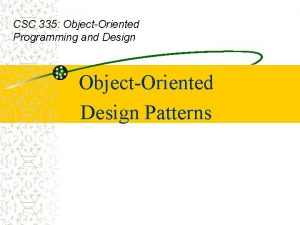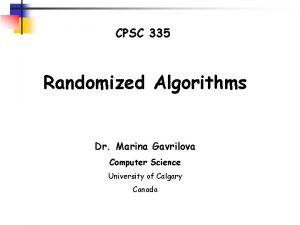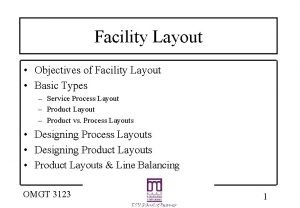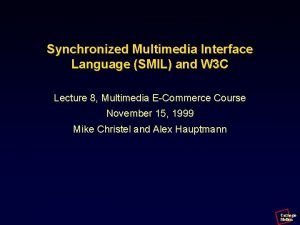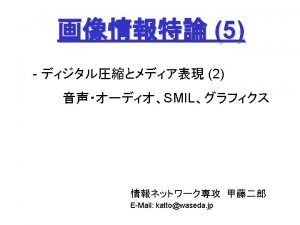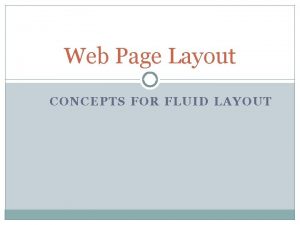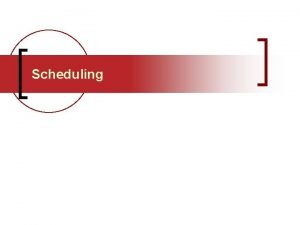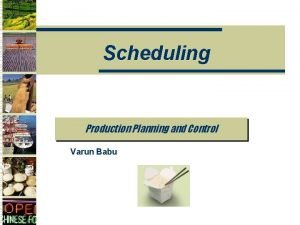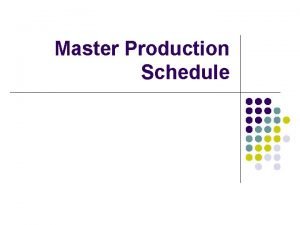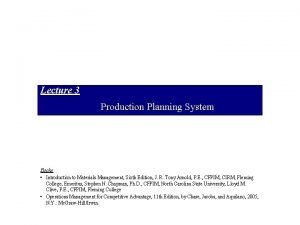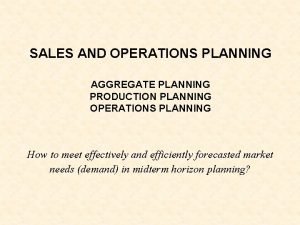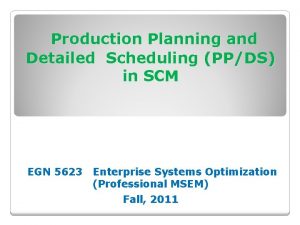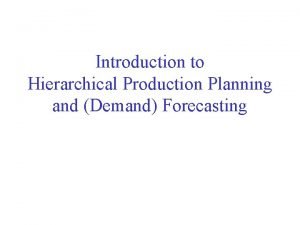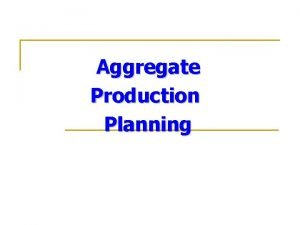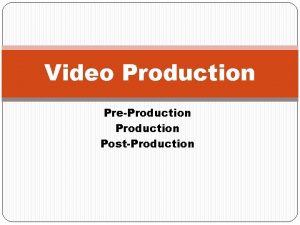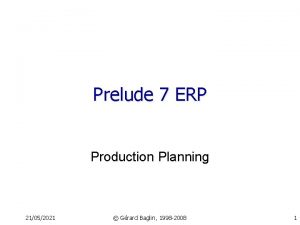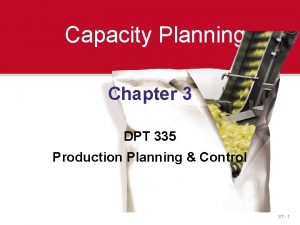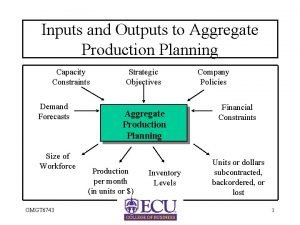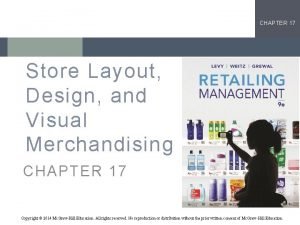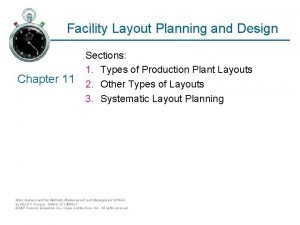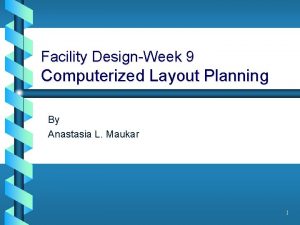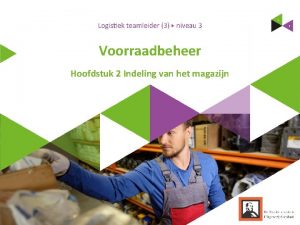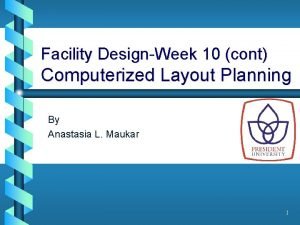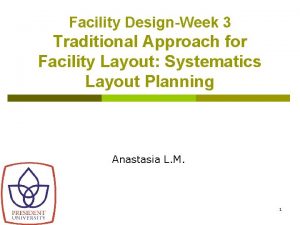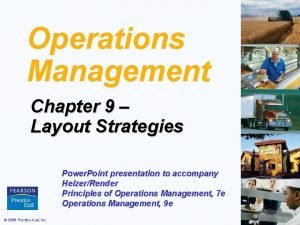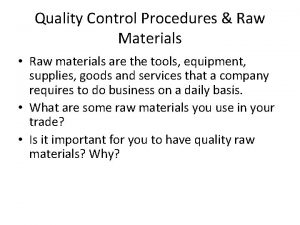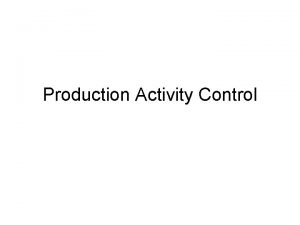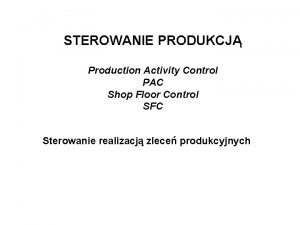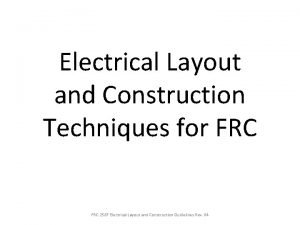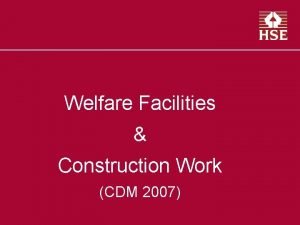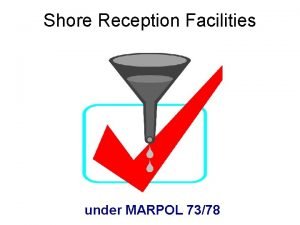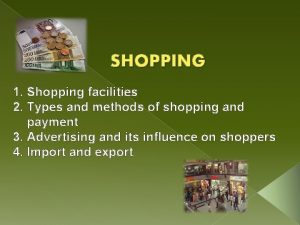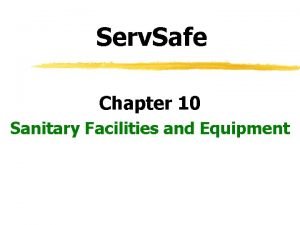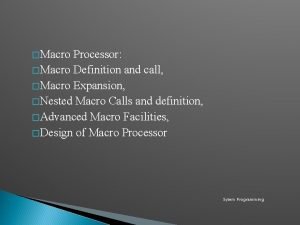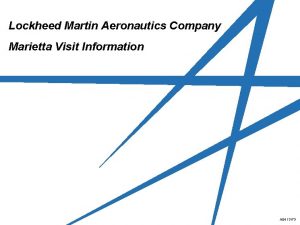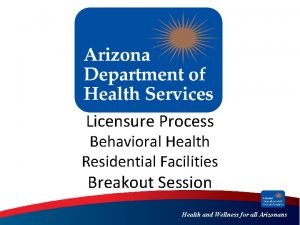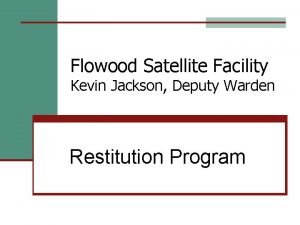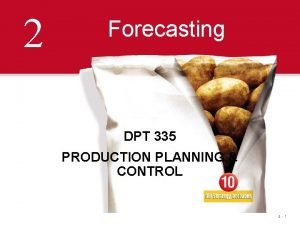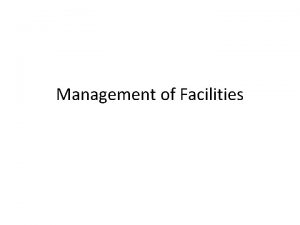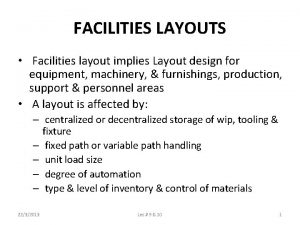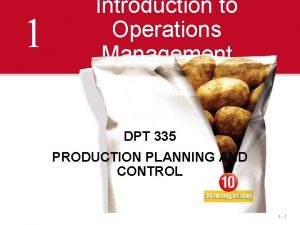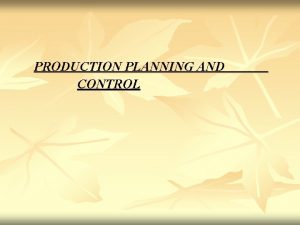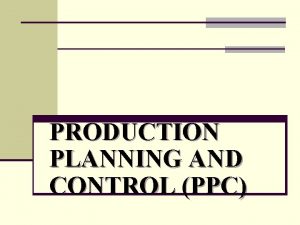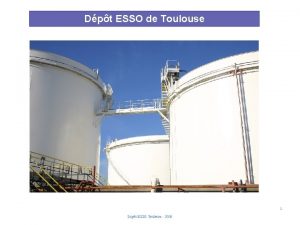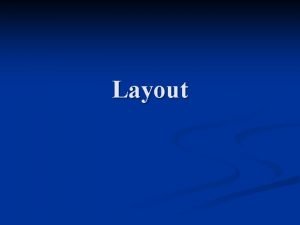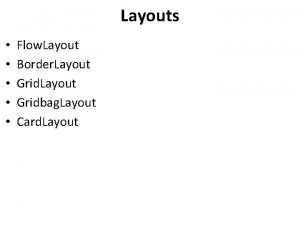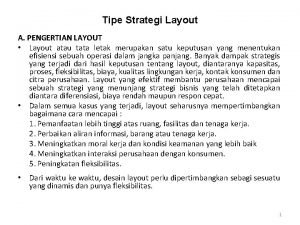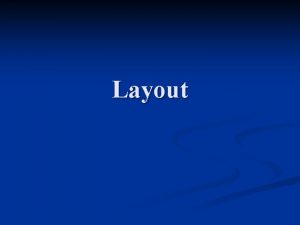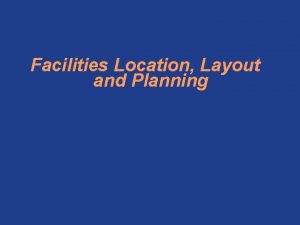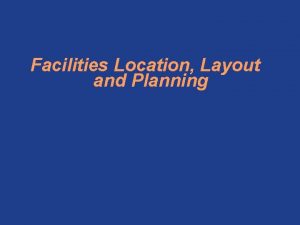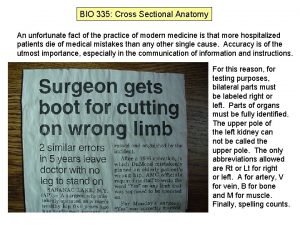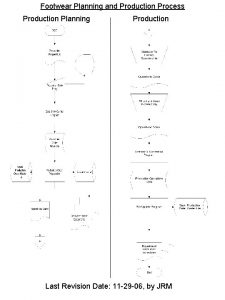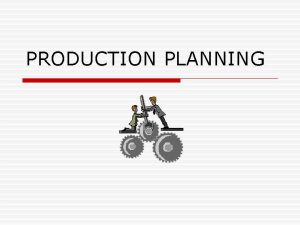4 Facilities Layout DPT 335 PRODUCTION PLANNING CONTROL













































































- Slides: 77

4 Facilities Layout DPT 335 PRODUCTION PLANNING & CONTROL 9 -1

Strategic Importance of Layout Decisions The objective of layout strategy is to develop an effective and efficient layout that will meet the firm’s competitive requirements 9 -2

Layout Design Considerations u Higher utilization of space, equipment, and people u Improved flow of information, materials, or people u Improved employee morale and safer working conditions u Improved customer/client interaction u Flexibility 9 -3

Types of Layout 1. Office layout 2. Retail layout 3. Warehouse layout 4. Fixed-position layout 5. Process-oriented layout 6. Work-cell layout 7. Product-oriented layout 9 -4

Types of Layout 1. Office layout: Positions workers, their equipment, and spaces/offices to provide for movement of information 2. Retail layout: Allocates shelf space and responds to customer behavior 3. Warehouse layout: Addresses tradeoffs between space and material handling 9 -5

Types of Layout 4. Fixed-position layout: Addresses the layout requirements of large, bulky projects such as ships and buildings 5. Process-oriented layout: Deals with low-volume, high-variety production (also called job shop or intermittent production) 9 -6

Types of Layout 6. Work cell layout: Arranges machinery and equipment to focus on production of a single product or group of related products 7. Product-oriented layout: Seeks the best personnel and machine utilizations in repetitive or continuous production 9 -7

Layout Strategies Objectives Office Retail Examples Locate workers requiring frequent contact close to one another Allstate Insurance Expose customer to highmargin items Kroger’s Supermarket Microsoft Corp. Walgreen’s Bloomingdale’s Warehouse (storage) Balance low cost storage with Federal-Mogul’s warehouse low-cost material handling The Gap’s distribution center Project (fixed position) Move material to the limited storage areas around the site Ingall Ship Building Corp. Trump Plaza Pittsburgh Airport Table 4. 1 9 -8

Layout Strategies Objectives Examples Job Shop (process oriented) Manage varied material flow for each product Arnold Palmer Hospital Work Cell (product families) Identify a product family, build teams, cross train team members Repetitive/ Continuous (product oriented) Equalize the task time at each Sony’s TV assembly line workstation Toyota Scion Hard Rock Cafe Olive Garden Hallmark Cards Wheeled Coach Standard Aero Table 4. 1 9 -9

Good Layouts Consider u Material handling equipment u Capacity and space requirements u Environment and aesthetics u Flows of information u Cost of moving between various work areas 9 - 10

Office Layout u Grouping of workers, their equipment, and spaces to provide comfort, safety, and movement of information u Movement of information is main distinction u Typically in state of flux due to frequent technological changes 9 - 11

Supermarket Retail Layout u Objective is to maximize profitability per square foot of floor space u Sales and profitability vary directly with customer exposure 9 - 12

Five Helpful Ideas for Supermarket Layout 1. Locate high-draw items around the periphery of the store 2. Use prominent locations for high-impulse and high-margin items 3. Distribute power items to both sides of an aisle and disperse them to increase viewing of other items 4. Use end-aisle locations 5. Convey mission of store through careful positioning of lead-off department 9 - 13

Store Layout Figure 9. 2 9 - 14

Retail Slotting u Manufacturers pay fees to retailers to get the retailers to display (slot) their product u Contributing factors u Limited shelf space u An increasing number of new products u Better information about sales through POS data collection u Closer control of inventory 9 - 15

Retail Store Shelf Space Planogram Shampoo Shampoo Conditioner u Often supplied by manufacturer Shampoo u Generated from store’s scanner data on sales Shampoo u Computerized tool for shelfspace management 5 facings 2 ft. 9 - 16

Warehousing and Storage Layouts u Objective is to optimize trade-offs between handling costs and costs associated with warehouse space u Maximize the total “cube” of the warehouse – utilize its full volume while maintaining low material handling costs 9 - 17

Warehousing and Storage Layouts Material Handling Costs u All costs associated with the transaction u Incoming transport u Storage u Finding and moving material u Outgoing transport u Equipment, people, material, supervision, insurance, depreciation u Minimize damage and spoilage 9 - 18

Warehousing and Storage Layouts u Warehouse density tends to vary inversely with the number of different items stored u Automated Storage and Retrieval Systems (ASRSs) can significantly improve warehouse productivity by an estimated 500% u Dock location is a key design element 9 - 19

Fixed-Position Layout u Product remains in one place, workers and equipment come to site u Complicating factors u Limited space at site u Different materials required at different stages of the project u Volume of materials needed is dynamic 9 - 20

Process-Oriented Layout u Layout that deals with low volume, high variety production in which like machines and equipment are grouped together u Flexible and capable of handling a wide variety of products or services u Scheduling can be difficult and setup, material handling, and labor costs can be high 9 - 21

Process-Oriented Layout ER triage room Patient A - broken leg Emergency room admissions Patient B - erratic heart pacemaker Surgery Laboratories Radiology ER Beds Pharmacy Billing/exit Figure 9. 3 9 - 22

Work Cells u Reorganizes people and machines into groups to focus on single products or product groups u Group technology identifies products that have similar characteristics for particular cells u Volume must justify cells u Cells can be reconfigured as designs or volume changes 9 - 23

Advantages of Work Cells 1. Reduced work-in-process inventory 2. Less floor space required 3. Reduced raw material and finished goods inventory 4. Reduced direct labor 5. Heightened sense of employee participation 6. Increased use of equipment and machinery 7. Reduced investment in machinery and equipment 9 - 24

Improving Layouts Using Work Cells Current layout - workers in small closed areas. Improved layout - cross-trained workers can assist each other. May be able to add a third worker as additional output is needed. Figure 9. 10 (a) 9 - 25

Improving Layouts Using Work Cells Current layout - straight lines make it hard to balance tasks because work may not be divided evenly Improved layout - in U shape, workers have better access. Four cross-trained workers were reduced. U-shaped line may reduce employee movement and space requirements while enhancing communication, reducing the number of workers, and facilitating inspection Figure 9. 10 (b) 9 - 26

Repetitive and Product. Oriented Layout Organized around products or families of similar high-volume, low-variety products 9 - 27

Product-Oriented Layouts u Fabrication line u Builds components on a series of machines u Machine-paced u Require mechanical or engineering changes to balance u Assembly line u Puts fabricated parts together at a series of workstations u Paced by work tasks u Balanced by moving tasks Both types of lines must be balanced so that the time to perform the work at each station is the same 9 - 28

Product-Oriented Layouts Advantages 1. 2. 3. 4. 5. Low variable cost per unit Low material handling costs Reduced work-in-process inventories Easier training and supervision Rapid throughput Disadvantages 1. High volume is required 2. Work stoppage at any point ties up the whole operation 3. Lack of flexibility in product or production rates 9 - 29

Mc. Donald’s Assembly Line Figure 9. 12 9 - 30

Assembly-Line Balancing u Objective is to minimize the imbalance between machines or personnel while meeting required output u Starts with the precedence relationships u Determine cycle time u Calculate theoretical minimum number of workstations u Balance the line by assigning specific tasks to workstations © 2011 Pearson Education 9 - 31

PERT and CPM u Network techniques u Developed in 1950’s u CPM by Du. Pont for chemical plants (1957) u PERT by Booz, Allen & Hamilton with the U. S. Navy, for Polaris missile (1958) u Consider precedence relationships and interdependencies u Each uses a different estimate of activity times © 2011 Pearson Education 9 - 32

Six Steps PERT & CPM 1. Define the project and prepare the work breakdown structure 2. Develop relationships among the activities - decide which activities must precede and which must follow others 3. Draw the network connecting all of the activities © 2011 Pearson Education 9 - 33

Six Steps PERT & CPM 4. Assign time and/or cost estimates to each activity 5. Compute the longest time path through the network – this is called the critical path 6. Use the network to help plan, schedule, monitor, and control the project © 2011 Pearson Education 9 - 34

Questions PERT & CPM Can Answer 1. When will the entire project be completed? 2. What are the critical activities or tasks in the project? 3. Which are the noncritical activities? 4. What is the probability the project will be completed by a specific date? © 2011 Pearson Education 9 - 35

Questions PERT & CPM Can Answer 5. Is the project on schedule, behind schedule, or ahead of schedule? 6. Is the money spent equal to, less than, or greater than the budget? 7. Are there enough resources available to finish the project on time? 8. If the project must be finished in a shorter time, what is the way to accomplish this at least cost? © 2011 Pearson Education 9 - 36

A Comparison of AON and AOA Network Conventions Activity on Node (AON) (a) A C B A (b) C B B (c) A C © 2011 Pearson Education Activity Meaning A comes before B, which comes before C. A and B must both be completed before C can start. B and C cannot begin until A is completed. Activity on Arrow (AOA) A B C A B A Figure 3. 5 C B C 9 - 37

A Comparison of AON and AOA Network Conventions Activity on Node (AON) A C B D (d) A C (e) B © 2011 Pearson Education D Activity Meaning C and D cannot begin until both A and B are completed. C cannot begin until both A and B are completed; D cannot begin until B is completed. A dummy activity is introduced in AOA. Activity on Arrow (AOA) A C B D A C Dummy activity B Figure 3. 5 D 9 - 38

A Comparison of AON and AOA Network Conventions Activity on Node (AON) A B (f) C © 2011 Pearson Education D Activity Meaning B and C cannot begin until A is completed. D cannot begin until both B and C are completed. A dummy activity is again introduced in AOA. Activity on Arrow (AOA) A Dummy activity Figure 3. 5 B D C 9 - 39

AON Example Milwaukee Paper Manufacturing's Activities and Predecessors Activity A Description Build internal components Immediate Predecessors — B Modify roof and floor — C Construct collection stack A D Pour concrete and install frame A, B E Build high-temperature burner C F Install pollution control system C G Install air pollution device D, E H Inspect and test F, G Table 3. 1 © 2011 Pearson Education 9 - 40

AON Network for Milwaukee Paper A Activity A (Build Internal Components) B Activity B (Modify Roof and Floor) Start Activity Figure 3. 6 © 2011 Pearson Education 9 - 41

AON Network for Milwaukee Paper Activity A Precedes Activity C A C B D Start Activities A and B Precede Activity D © 2011 Pearson Education Figure 3. 7 9 - 42

AON Network for Milwaukee Paper F A C E Start B D H G Arrows Show Precedence Relationships © 2011 Pearson Education Figure 3. 8 9 - 43

AOA Network for Milwaukee Paper © 2011 Pearson Education (Construct Stack) Dummy Activity 3 4 D (Pour Concrete/ Install Frame) F Co (In nt sta ro ll ls ) E Ro (M B of od /F ify lo or ) C (Build Burner) 1 (B C ui om ld A po Int ne ern nt al s) 2 5 6 H (Inspect/ Test) 7 G l al on t s I( n lluti ce) i Po ev D Figure 3. 9 9 - 44

Determining the Project Schedule Perform a Critical Path Analysis u The critical path is the longest path through the network u The critical path is the shortest time in which the project can be completed u Any delay in critical path activities delays the project u Critical path activities have no slack time © 2011 Pearson Education 9 - 45

Determining the Project Schedule Perform a Critical Path Analysis Activity A B C D E F G H Description Time (weeks) Build internal components 2 Modify roof and floor 3 Construct collection stack 2 Pour concrete and install frame 4 Build high-temperature burner 4 Install pollution control system 3 Install air pollution device 5 Inspect and test 2 Total Time (weeks) 25 Table 3. 2 © 2011 Pearson Education 9 - 46

Determining the Project Schedule Perform a Critical Path Analysis Earliest start (ES) = earliest time at which an activity can Activity Description Time (weeks) start, assuming all predecessors have A Build internal components 2 been completed Modify roof and floor 3 Earliest. Bfinish (EF) = earliest time at which an activity can be finished C Construct collection stack 2 D start (LS) Pour=concrete and 4 Latest latest time atinstall which frame an activity can start so as to not delay E Build high-temperature burnerthe completion 4 of thecontrol entire project F Install time pollution system 3 Latest. Gfinish (LF) = latest time bydevice which an activity has Install air pollution 5 to be finished so as to not delay the H Inspect and test 2 completion time of the entire project Total Time (weeks) 25 Table 3. 2 © 2011 Pearson Education 9 - 47

Determining the Project Schedule Perform a Critical Path Analysis Activity Name or Symbol A Earliest Start ES EF Latest Start LS LF Figure 3. 10 © 2011 Pearson Education 2 Earliest Finish Latest Finish Activity Duration 9 - 48

Forward Pass Begin at starting event and work forward Earliest Start Time Rule: u If an activity has only a single immediate predecessor, its ES equals the EF of the predecessor u If an activity has multiple immediate predecessors, its ES is the maximum of all the EF values of its predecessors ES = Max {EF of all immediate predecessors} © 2011 Pearson Education 9 - 49

Forward Pass Begin at starting event and work forward Earliest Finish Time Rule: u The earliest finish time (EF) of an activity is the sum of its earliest start time (ES) and its activity time EF = ES + Activity time © 2011 Pearson Education 9 - 50

ES/EF Network for Milwaukee Paper ES EF = ES + Activity time 0 Start 0 0 © 2011 Pearson Education 9 - 51

ES/EF Network for Milwaukee Paper EF of A = ES of A + 2 ES of A 0 Start 0 0 A 2 0 2 © 2011 Pearson Education 9 - 52

ES/EF Network for Milwaukee Paper 0 A 2 0 Start 0 0 2 EF of B = ES of B + 3 ES of B 0 B 3 3 © 2011 Pearson Education 9 - 53

ES/EF Network for Milwaukee Paper 0 A 2 2 0 Start 2 C 4 2 0 0 0 B 3 3 © 2011 Pearson Education 9 - 54

ES/EF Network for Milwaukee Paper 0 A 2 2 0 Start 0 2 C 4 2 = Max (2, 3) 0 D 3 0 B 3 © 2011 Pearson Education 7 3 4 9 - 55

ES/EF Network for Milwaukee Paper 0 A 2 2 2 0 Start C 4 2 0 0 0 B 3 © 2011 Pearson Education 3 3 D 7 4 9 - 56

ES/EF Network for Milwaukee Paper 0 A 2 2 2 0 Start C 4 4 2 F 7 3 0 4 0 E 8 13 4 0 B 3 3 3 D 4 7 H 15 2 8 G 13 5 Figure 3. 11 © 2011 Pearson Education 9 - 57

Backward Pass Begin with the last event and work backwards Latest Finish Time Rule: u If an activity is an immediate predecessor for just a single activity, its LF equals the LS of the activity that immediately follows it u If an activity is an immediate predecessor to more than one activity, its LF is the minimum of all LS values of all activities that immediately follow it LF = Min {LS of all immediate following activities} © 2011 Pearson Education 9 - 58

Backward Pass Begin with the last event and work backwards Latest Start Time Rule: u The latest start time (LS) of an activity is the difference of its latest finish time (LF) and its activity time LS = LF – Activity time © 2011 Pearson Education 9 - 59

LS/LF Times for Milwaukee Paper 0 A 2 2 2 0 Start C 4 4 2 F 7 3 0 4 0 E 8 13 13 4 0 B 3 © 2011 Pearson Education 3 LS = LF D – Activity time G 3 7 4 8 5 H 2 15 15 13 LF = EF of Project 9 - 60

LS/LF Times for Milwaukee Paper 0 A 2 2 2 0 Start C 4 4 10 2 F 3 7 13 E 0 8 of LF =4 Min(LS following activity) 0 13 13 4 0 B 3 © 2011 Pearson Education 3 3 D 4 7 8 G H 2 15 15 13 5 9 - 61

LS/LF Times for LF = Min(4, 10) Milwaukee Paper 0 A 2 2 2 0 Start 2 C 2 4 4 4 10 0 4 4 0 0 B 3 © 2011 Pearson Education 3 3 D 4 7 E 4 F 3 7 13 8 8 G 5 H 2 15 15 13 13 9 - 62

LS/LF Times for Milwaukee Paper 0 0 Start 0 A 2 2 2 C 2 4 4 4 10 0 4 0 1 © 2011 Pearson Education B 3 3 3 4 4 D 4 E 4 F 3 7 13 8 13 7 8 8 8 G 5 H 2 15 15 13 13 9 - 63

Computing Slack Time After computing the ES, EF, LS, and LF times for all activities, compute the slack or free time for each activity u Slack is the length of time an activity can be delayed without delaying the entire project Slack = LS – ES © 2011 Pearson Education or Slack = LF – EF 9 - 64

Computing Slack Time Earliest Start Finish Activity ES EF A B C D E F G H 0 0 2 3 4 4 8 13 2 3 4 7 8 7 13 15 Latest Start LS Latest Finish LF Slack LS – ES On Critical Path 0 1 2 4 4 10 8 13 2 4 4 8 8 13 13 15 0 1 0 6 0 0 Yes No Yes Table 3. 3 © 2011 Pearson Education 9 - 65

Critical Path for Milwaukee Paper 0 0 Start 0 A 2 2 2 C 2 4 4 4 10 0 4 0 1 © 2011 Pearson Education B 3 3 3 4 4 D 4 E 4 F 3 7 13 8 13 7 8 8 8 G 5 H 2 15 15 13 13 9 - 66

ES – EF Gantt Chart for Milwaukee Paper 1 2 3 4 5 6 7 8 9 10 11 12 13 14 15 16 A Build internal components B Modify roof and floor C Construct collection stack D Pour concrete and install frame E Build hightemperature burner F Install pollution control system G Install air pollution device H Inspect and test © 2011 Pearson Education 9 - 67

LS – LF Gantt Chart for Milwaukee Paper 1 2 3 4 5 6 7 8 9 10 11 12 13 14 15 16 A Build internal components B Modify roof and floor C Construct collection stack D Pour concrete and install frame E Build hightemperature burner F Install pollution control system G Install air pollution device H Inspect and test © 2011 Pearson Education 9 - 68

Advantages of PERT/CPM 1. Especially useful when scheduling and controlling large projects 2. Straightforward concept and not mathematically complex 3. Graphical networks help highlight relationships among project activities 4. Critical path and slack time analyses help pinpoint activities that need to be closely watched © 2011 Pearson Education 9 - 69

Advantages of PERT/CPM 5. Project documentation and graphics point out who is responsible for various activities 6. Applicable to a wide variety of projects 7. Useful in monitoring not only schedules but costs as well © 2011 Pearson Education 9 - 70

Limitations of PERT/CPM 1. Project activities have to be clearly defined, independent, and stable in their relationships 2. Precedence relationships must be specified and networked together 3. Time estimates tend to be subjective and are subject to fudging by managers 4. There is an inherent danger of too much emphasis being placed on the longest, or critical, path © 2011 Pearson Education 9 - 71

Wing Component Example Performance Time Task (minutes) A 10 B 11 C 5 D 4 E 12 F 3 G 7 H 11 I 3 Total time 66 Task Must Follow Task Listed Below — A B B A C, D F E G, H This means that tasks B and E cannot be done until task A has been completed 9 - 72

Wing Component Example Performance Time Task (minutes) A 10 B 11 C 5 D 4 E 12 F 3 G 7 H 11 I 3 Total time 66 Task Must Follow Task Listed Below — A B B A C, D F E G, H 5 10 11 A B 12 E C 4 D 3 7 F G 3 11 I H Figure 9. 13 9 - 73

Wing Component Example Performance Time Task (minutes) A 10 B 11 C 5 D 4 E 12 F 3 G 7 H 11 I 3 Total time 66 480 available mins per day 40 units required Task Must Follow Task Listed Below — A Production time B available per day Cycle B time = Units required per day A = 480 / 40 5 C, D = 12 minutes per unit C F 10 11 3 7 n E for task. Fi A ∑ Time B G Minimum G, H 4 i=1 number of = workstations Cycle Dtime 12 11 3 I = 66 / 12 E H = 5. 5 or 6 stations Figure 9. 13 9 - 74

Heuristics Wing. Line-Balancing Component Example 1. Longest task time Choose the available 480 task available Performance Task Must Follow with the longest task time mins per day Time Task Listed 40 task units required Task 2. Most (minutes) following tasks. Below Choose the available number of= 12 mins A 10 —with the largest. Cycle time B 11 Afollowing tasks. Minimum = 5. 5 or 6 C 3. Ranked 5 positional BChoose the available workstations task for D Bwhich the sum of following weight 4 E 12 Atask times is the longest 5 F 3 C, D the available C task G 4. Shortest 7 task time FChoose 10 shortest 11 3 7 with the task time H 11 E A B G F I 5. Least number 3 G, H 4 of Choose the available task 3 with the least number of Totalfollowing time 66 tasks D I 12 11 following tasks E H Table 9. 4 Figure 9. 13 9 - 75

Wing Component Example Performance Time Task (minutes) A 10 B 11 Station C 52 D 4 11 E 10 12 B F A 3 G 7 H 11 I 3 12 Stationtime 66 Total E 1 Station 4 © 2011 Pearson Education 480 available mins per day 40 units required Task Must Follow Task Listed Below — Cycle time = 12 mins A Minimum 5 B = 5. 5 or 6 workstations C B 3 7 A G C, D F 4 3 F D E Station 3 I Station 3 G, H 11 H Station 5 Station 6 6 Station Figure 9. 14 9 - 76

Wing Component Example Performance Time Task (minutes) Task Must Follow Task Listed Below 480 available mins per day 40 units required A 10 — Cycle time = 12 mins B 11 A Minimum = 5. 5 or 6 C 5 B workstations D 4 B E 12 A F 3 C, D ∑ Task times G 7 F Efficiency = (Actual number of. Eworkstations) x (Largest cycle time) H 11 I 3 G, H = 66 minutes / (6 stations) x (12 minutes) Total time 66 = 91. 7% 9 - 77
 Post produksi
Post produksi Limitations of liquid penetrant testing
Limitations of liquid penetrant testing Dpt psychology
Dpt psychology Dpt 110
Dpt 110 Dpt 110
Dpt 110 Oasif
Oasif Psychrometry is the study of
Psychrometry is the study of Vcu dpt
Vcu dpt Facility layout
Facility layout Objective of good plant layout
Objective of good plant layout Production planning means
Production planning means Qc meaning
Qc meaning Route card in manufacturing
Route card in manufacturing Objectives of production planning & control *
Objectives of production planning & control * Production planning and inventory control
Production planning and inventory control What is facility planning
What is facility planning Define facility planning
Define facility planning Tata letak lokasi
Tata letak lokasi Reject allowance problem facilities planning
Reject allowance problem facilities planning Marine facilities planning
Marine facilities planning Material handling and facilities planning
Material handling and facilities planning Caucalor
Caucalor Systematic layout planning example
Systematic layout planning example Apple's plant layout procedure
Apple's plant layout procedure Toronto to mauritius
Toronto to mauritius Csc 335
Csc 335 Cpsc 335
Cpsc 335 Cpsc 335
Cpsc 335 Cmsc335
Cmsc335 Comp 335
Comp 335 Cmsc 335
Cmsc 335 30 tac 335
30 tac 335 30 tac 335
30 tac 335 30 tac 335
30 tac 335 Sim 335
Sim 335 Psy 335 purdue
Psy 335 purdue Builder design pattern uml diagram
Builder design pattern uml diagram Cpsc 335
Cpsc 335 Draw a layout of your production area
Draw a layout of your production area Aeioux layout
Aeioux layout Numerator vs denominator layout
Numerator vs denominator layout Smil head layout root-layout
Smil head layout root-layout Smil head layout root-layout
Smil head layout root-layout Fixed vs fluid layout
Fixed vs fluid layout Production planning process
Production planning process Varun babu
Varun babu Production schedules examples
Production schedules examples Production planning books
Production planning books Aggregate planning models
Aggregate planning models Detailed scheduling
Detailed scheduling Demand forecasting introduction
Demand forecasting introduction Advantages and disadvantages of aggregate planning
Advantages and disadvantages of aggregate planning Pre production planning for video film and multimedia
Pre production planning for video film and multimedia Prelude 7 erp
Prelude 7 erp Bakery production planning
Bakery production planning Mps adalah
Mps adalah Corelap 01
Corelap 01 Store layout ideas
Store layout ideas Closeness rating
Closeness rating Computerized layout techniques
Computerized layout techniques Magazijn indeling
Magazijn indeling Craft layout example
Craft layout example Space relationship diagram
Space relationship diagram The central problem in product-oriented layout planning is:
The central problem in product-oriented layout planning is: Raw material quality control
Raw material quality control Production activity control
Production activity control Shop floor control
Shop floor control Production activity control
Production activity control Frc electrical components
Frc electrical components Cdm welfare facilities
Cdm welfare facilities Shore reception facilities
Shore reception facilities Shopping facilities examples
Shopping facilities examples What is coving servsafe
What is coving servsafe Differentiate between macro and subroutine
Differentiate between macro and subroutine Lockheed marietta georgia
Lockheed marietta georgia Article 7 behavioral health residential facilities
Article 7 behavioral health residential facilities Disqualification of testing facilities
Disqualification of testing facilities Flowood satellite facility
Flowood satellite facility

